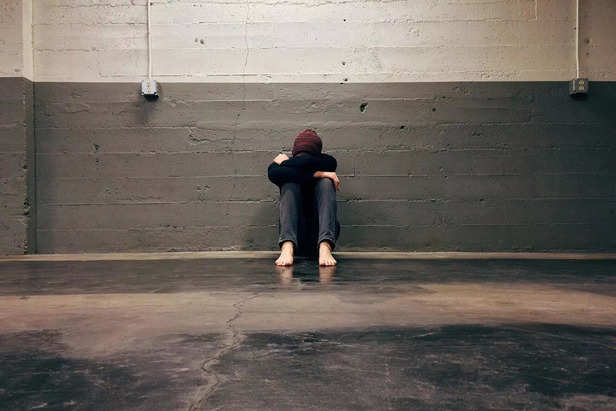Silent Scars: Understanding Why People Self-Harm
Ankita Rai | Sat, 29 Mar 2025
A hidden war that many people fight in silence is self-harm. Recovery depends on knowing the signs, causes, and therapies of self-harm. The causes of self-harm, warning indicators to watch out for, and practical coping mechanisms to recover and move on are all covered in this article. Knowledge and compassion can help, whether you're going through something yourself or are helping a loved one.
slient war
( Image credit : Pexels )
Self-harm is a secret battle, a whisper of pain tucked away under long sleeves and soft smiles. It’s not only about physical wounds; it’s about profound emotional upheaval that people outside of its experience cannot comprehend. If you or someone you know is dealing with this struggle, understanding its signs, causes and ways to heal can be the first step in breaking free.

Self-harm (also referred to as non-suicidal self-injury or NSSI) is the intentional act of hurting oneself to soothe big feelings. It can take many forms — cutting, burning, scratching, hitting or pulling out hair. Although it is not an indicator of suicidal ideation, it is indeed a cry for help, a maladaptive coping strategy, yielding from emotional suffering.

Because self-harm is usually done in secret, it can be hard to recognize. But there are a few signs the struggle lurks below the surface:
Cuts, bruises, burns, or scars that are unexplained
Use of long sleeves or pants, even in warm weather
Staying clear of scenarios where skin can be revealed, like diving
Having a sharp stick or lighter nearby
Falling off from social interactions
Expressing feelings of guilt, emptiness, or worthlessness
These signals — ember-on-the-water signals, sandcastle signals — if we can spot them early, we can build a bridge to help build a bridge to better understanding, better support.

Self-harm is not a way to get attention — it is a way to cope with emotional pain. The reasons differ, but here are some common causes:
Self-harm can serve as a way of temporarily switching off or releasing strong feelings when they become excruciating.
Past hurtful experiences, especially as a child, can contribute to self-harming as a means of coping.
Struggles with
Depression, anxiety, borderline personality disorder (BPD), and trauma or PTSD are some of the most common mental illnesses associated with self-harm.
If one has low self-esteem, one may have the feeling that a person “deserves” pain and turn to self-harm as a punishment.
For some people, self-harm serves as a way to feel something — anything — during periods of numbness.
Exposure to self-harm in friend groups or online communities can make the behavior seem normal, especially in adolescents.
It’s vital to understand the why behind self-harm in order to provide effective support.

Recovery from self-harm doesn’t stop at ending the behavior — it’s about treating the pain that resides beneath it. Here is how to take the first step toward recovery:
Works to identify negative thought patterns and replace them with healthier coping strategies.
While more specific to the context of Borderline Personality Disorder, DBT is a therapeutic approach that teaches skills for emotional regulation and interpersonal effectiveness.
Works on past trauma that may be the root of self-harm as a coping mechanism.
Although self-harm is not treated with medication, conditions such as depression or anxiety can be involved, and antidepressants or mood stabilizers might help.
Healthy Alternatives to Self-Harm

They can express their emotions through:
Expressing emotions through writing rather than urges.
Physical activity releases feel-good chemicals (endorphins) that will naturally boost your mood.
Create something — a piece of art, music, or just write — to process your feelings.
Assists people in remaining calm and grounded in stressful times.
You shouldn’t struggle alone — speaking with a trusted friend, family member or therapist can be a lifeline.
Support groups can combat the isolation that often comes with self-harm.
People often don’t seek help because of the stigma attached to self-harm. Many are afraid of being judged, misunderstood or rejected. But open discussions about self-harm can break down these barriers, paving the way for support and healing. If someone opens up to you about their struggle, try to listen with empathy, not criticism. You could be the guiding light of healing for them.

Self-harm is a symptom of profound pain, and pain can be a message to a person that their future need not be determined by pain. Recovery is achievable—with patience, love, guidance, and the right tools, those who self-harm can learn healthier ways to cope and take control of their feelings. If you or someone you know is in crisis, don’t hesitate to reach out for support. You aren’t alone, and you deserve to heal.
Unlock insightful tips and inspiration on personal growth, productivity, and well-being. Stay motivated and updated with the latest at My Life XP.
What Is Self-Harm?

understanding self harm
( Image credit : Pexels )
Self-harm (also referred to as non-suicidal self-injury or NSSI) is the intentional act of hurting oneself to soothe big feelings. It can take many forms — cutting, burning, scratching, hitting or pulling out hair. Although it is not an indicator of suicidal ideation, it is indeed a cry for help, a maladaptive coping strategy, yielding from emotional suffering.
Recognizing the Signs That Someone Is Self-Harming

self harm
( Image credit : Pexels )
Because self-harm is usually done in secret, it can be hard to recognize. But there are a few signs the struggle lurks below the surface:
Cuts, bruises, burns, or scars that are unexplained
Use of long sleeves or pants, even in warm weather
Staying clear of scenarios where skin can be revealed, like diving
Having a sharp stick or lighter nearby
Falling off from social interactions
Expressing feelings of guilt, emptiness, or worthlessness
These signals — ember-on-the-water signals, sandcastle signals — if we can spot them early, we can build a bridge to help build a bridge to better understanding, better support.
Why Do People Self-Harm?

bruises
( Image credit : Freepik )
Self-harm is not a way to get attention — it is a way to cope with emotional pain. The reasons differ, but here are some common causes:
Excessive Emotions:
Trauma or Abuse:
Struggles with Mental Health :
Self-Punishment:
Emotional Numbness:
Glimpses from Media or People:
It’s vital to understand the why behind self-harm in order to provide effective support.
Moving Forward — Treatments and Coping Methods

taking help
( Image credit : Pixabay )
Recovery from self-harm doesn’t stop at ending the behavior — it’s about treating the pain that resides beneath it. Here is how to take the first step toward recovery:
Seeking Professional Help
Cognitive Behavioral Therapy (CBT):
Dialectical Behavior Therapy (DBT):
Trauma Therapy:
Managing Preexisting Conditions
Healthy Alternatives to Self-Harm

expressing emotions
( Image credit : Pexels )
They can express their emotions through:
Journaling:
Exercise:
Artistic Expression:
Meditation & Mindfulness:
Building a Support System
Support groups can combat the isolation that often comes with self-harm.
The Importance of Discussing Self-Harm: Breaking the Silence
Hope and Healing Are Possible

hope
( Image credit : Pexels )
Self-harm is a symptom of profound pain, and pain can be a message to a person that their future need not be determined by pain. Recovery is achievable—with patience, love, guidance, and the right tools, those who self-harm can learn healthier ways to cope and take control of their feelings. If you or someone you know is in crisis, don’t hesitate to reach out for support. You aren’t alone, and you deserve to heal.
Unlock insightful tips and inspiration on personal growth, productivity, and well-being. Stay motivated and updated with the latest at My Life XP.
Frequently Asked Questions (FAQs)
- How do you identify self-harm?
Signs of emotional anguish, seclusion, frequent skin covering, and unexplained injuries are all indicators of self-harm. - How do I stop self-harm urges?
Self-harm desires can be controlled by practicing alternate coping mechanisms like writing, exercise, or deep breathing. - If you cut yourself, what should you do?
Clean the wound, apply pressure to stop the bleeding, and get medical help if you cut yourself. - How can self-harm be treated?
Therapy (CBT, DBT), medication for underlying disorders, and the development of healthy emotional coping strategies are all ways to address self-harm.











